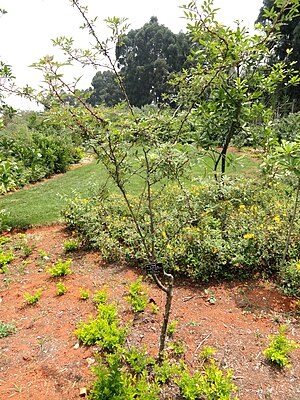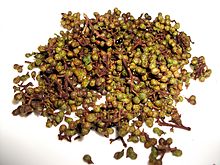Zanthoxylum acanthopodium
This article was based on formal or substantive deficiencies in the quality assurance biology in the section "plants" entered for improvement. This is done in order to bring the quality of the biology articles to an acceptable level. Please help improve this article! Articles that are not significantly improved can be deleted if necessary.
Read the more detailed information in the minimum requirements for biology articles .
| Zanthoxylum acanthopodium | ||||||||||||
|---|---|---|---|---|---|---|---|---|---|---|---|---|

Zanthoxylum acanthopodium |
||||||||||||
| Systematics | ||||||||||||
|
||||||||||||
| Scientific name | ||||||||||||
| Zanthoxylum acanthopodium | ||||||||||||
| DC. |
Zanthoxylum acanthopodium is a species in the genus Zanthoxylum within the family of the Rutaceae (Rutaceae). Its dried fruits are usedas a spicein Asia under the name Andaliman or Indonesian lemon pepper . Zanthoxylum acanthopodium is not related to the black pepper ( Piper nigrum ).
description
Zanthoxylum acanthopodium grows as a prickly, small, diocese tree or shrub and reaches a height of about 6 meters.
The stalked leaves are unpinnate with a winged rachis. The up to about 11 almost sessile and paired, short-stalked, pointed and notched leaflets are ovate to lanceolate. The veins are pronounced and pinnate. The petioles, the rachis and the central vein of the leaflets, the stem and the branches are often reddish and they have reddish spines . There are oil glands on the leaves, trunk and branches.
Short, axially and paniculate inflorescences are formed. The short-stalked flowers are yellowish-green with 6–8 tepals and a fleshy nectar disc . The male flowers have 5–6 stamens and a stunted ovary , the female none. The female flowers have an ovary of 2–5 carpels, it often has an oil gland. The stylus is in two parts.
The small, almost bare, knobbed and round fruits are purple-red, single-seeded follicles with oil glands, they are about 4 mm in size. The black, shiny seeds with a soft seed coat are about 3 mm in size.
The number of chromosomes is 2n = 64.
ecology
It only spreads through birds, resulting in widespread and irregular distribution. Only enzymes in the digestive tract of some bird species allow the seeds to germinate. All attempts at cultivation have so far failed.
distribution
The distribution area of Zanthoxylum acanthopodium extends from the Indian subcontinent India ( Arunachal Pradesh , Assam , Manipur , Meghalaya , Mizoram , Nagaland , Uttar Pradesh , West Bengal ), Bangladesh via the Himalayan states of Sikkim , Bhutan , Nepal and Tibet to the Chinese provinces of Guizhou , Sichuan , Yunnan as well as Guangxi and Laos , Myanmar , Thailand , Vietnam , Sumatra and Malaysia .
Taxonomy
The first description of Zanthoxylum acanthopodium was made in 1824 by Augustin Pyramus de Candolle in Prodromus Systematis Naturalis Regni Vegetabilis , 1, p 727. There are known some synonyms.
use
The seeds are used as a spice and have a mild pepper taste, lemongrass note and a slightly numbing effect. Other types of Zanthoxylum provide types of spice known as Szechuan pepper . The dried fruits and branches are marketed as Andaliman pepper, Indonesian lemon pepper or other names.
An essential oil is extracted from the fruits, which is used in perfumery.
The seeds and bark are used medicinally. The wood is used for different things.
literature
- Zanthoxylum acanthopodium in the Flora of China, Vol. 11.
Web links
- Zanthoxylum acanthopodium from Useful Tropical Plants, accessed October 7, 2018.
- Zanthoxylum acanthopodium from Botanical Survey of India, accessed October 8, 2018.
Individual evidence
- ↑ a b c Zanthoxylum acanthopodium in the Germplasm Resources Information Network (GRIN), USDA , ARS , National Genetic Resources Program. National Germplasm Resources Laboratory, Beltsville, Maryland. Retrieved July 22, 2016.
- ↑ a b c Umberto Quattrocchi: CRC World Dictionary of Medicinal and Poisonous Plants. CRC Press, 2012, ISBN 978-1-4822-5064-0 , p. 3983.
- ↑ Zanthoxylum acanthopodium at Tropicos.org. In: IPCN Chromosome Reports . Missouri Botanical Garden, St. Louis
- ↑ Zanthoxylum acanthopodium at Tropicos.org. Missouri Botanical Garden, St. Louis, accessed July 27, 2016.
